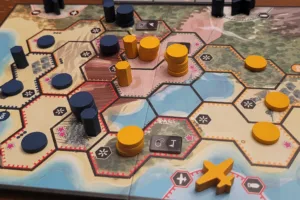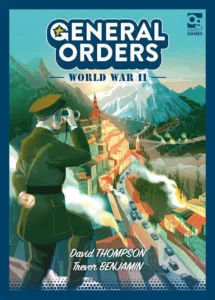 War games and historical games are an intimidating genre. They’re usually big and complicated, with lots of little components and fiddly rules, and because they tackle more serious themes, they can be uncomfortable to engage with. It’s more difficult to enjoy combat and violence when you’re made aware of the real-world context of said violence.
War games and historical games are an intimidating genre. They’re usually big and complicated, with lots of little components and fiddly rules, and because they tackle more serious themes, they can be uncomfortable to engage with. It’s more difficult to enjoy combat and violence when you’re made aware of the real-world context of said violence.
Luckily, General Orders: World War II avoids these concerns by being compact, fast, easy to learn, and completely devoid of real-world context. A historical game without any history is certainly a bold move, but does it pay off?
General Orders is a two-player worker placement/area control game, that takes around 30 minutes to play.
Gameplay Overview:
In General Orders, players start with troops on opposite ends of the map near their HQ, and fight to control high-value areas in the center of the map by game end. (A player controls an area if they have any troops in that area.)

On each of the game’s four rounds, players take turns placing their workers on one of the available action spaces and taking that action. Most actions revolve around managing troops on the map—moving them into new areas, reinforcing existing troops, bombing enemy troops, and so on. Some actions instead let you draw operations cards, which can be spent to either re-roll dice in combat, or as a powerful bonus to a specific action.
Each action can only be taken once per round. Additionally, a player can’t take an action on the map unless they supply the relevant area, meaning the area is connected to their HQ via other areas they control. This means that, generally speaking, your home territory can only be used by you, but you must race to take actions in contested areas.
If one player ever moves troops into an area with the other player’s troops, it immediately triggers combat. The defending player rolls a die and removes that many attacking troops, then troops are removed one at a time from each side until one player’s troops are all gone.
If either player loses control of their HQ, the other player immediately wins the game. Alternatively, at the end of the fourth round, players will total the points gained from the areas they control, and the player with the most points wins.

Game Experience:
Both mechanically and thematically, General Orders is a lot drier than it first appears. The World War II theme is completely absent (the two sides of the conflict aren’t even named, just given colors), and the combat is simple and minimalist. In terms of game feel, General Orders is more at home with quick-playing abstract games like Hive and Onitama than it is with modern war games.

And yet, as an abstract game, General Orders threatens to be derailed by its own randomness. The dice aren’t actually a problem—combat results are fairly predictable, and that bit of unpredictability leads to interesting tactical decisions. However, the operations cards are swingy to the point of unfairness. These cards aren’t just powerful, they’re unpredictable—you never know what your opponent has, and the effects can range from “mildly annoying” to “game-winning” depending on the situation. Roughly one-third of my games felt determined by a player having the right card at the right time, which is irritating for a game that is otherwise so brutally deterministic.
If you can handle that occasional frustration, though, General Orders is otherwise a tense and tightly-balanced duel. Worker placement and conflict-heavy area control is an odd combination, but it leads to a surprising amount of depth, and each round presents different choices of when to advance and when to hold back. In addition to point values, some areas have randomly-placed bonus tokens, which enhance a specific action for whoever controls that area. In stark contrast to the randomness of the operations cards, these bonus tokens add interesting nuances to the game, because players might be more interested in different bonuses at different times. For a game with only four or five actions, General Orders manages to never feel stale, thanks to the ever-shifting state of the map.

General Orders also gets solid replay value from its variable setup. In addition to the randomized placement of bonus tokens, General Orders comes with two different maps, each with their own distinct flavor. The Alpine map is completely symmetric and sees players para-dropping troops all across the map, whereas the Island map is much more asymmetric and adds airplanes—essentially troops that move on a different set of spaces. The rules differences are minor, but they lead to quite different game arcs, which keeps things fresh over repeated plays.
That said, while General Orders is a simple game, the rulebook doesn’t do a great job of showing that. The rules are explained rigidly and rigorously, which makes them easy to reference, but hard to learn the game from. In my first few games, I found myself constantly re-reading the rules to make sure I understood things correctly, because the game isn’t explained in a way that makes intuitive sense.
Final Thoughts:
General Orders sits at a strange crossroads—an abstract worker placement game with a light drizzle of thematic set dressing, and a deluge of potentially game-breaking card luck. The core of the game is solid and a lot of fun, but you need to be okay with the pairing of dry, difficult decisions and unfair swings of fortune to access that fun.
Final Score: 3.5 – A quick, tightly-balanced worker placement wargame, but with too much randomness for some people’s tastes.
 Hits:
Hits:
• Worker placement leads to tense decisions
• Surprising depth for a game this small and fast
• Randomized setup is appreciated
Misses:
• Mechanically and thematically dry
• Operations cards create too much swinginess
• Harder to learn than it should be
Source: Board Game Quest





